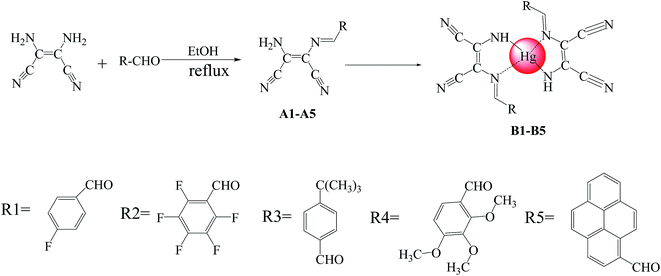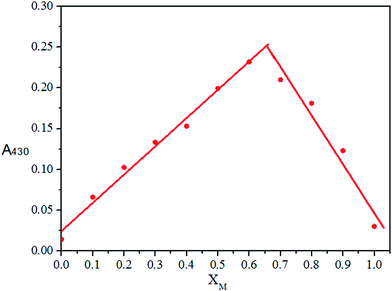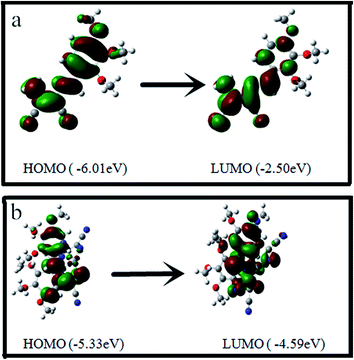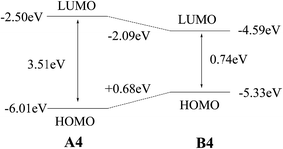Highly selective and sensitive colorimetric chemosensors for Hg2+ based on novel diaminomaleonitrile derivatives†
Yanping Huo*ab,
Songying Wanga,
Tianhua Lua,
Chengqiang Pana,
Yujing Lua,
Xianghua Yanga,
Dongping Hua and
Sheng Hua
aSchool of Chemical Engineering and Light Industry, Guangdong University of Technology, Guangzhou 510006, China. E-mail: yphuo@gdut.edu.cn; Fax: +86 20 39322235; Tel: +86 20 39322236 Tel: +86 13798135622
bKey Laboratory of Organofluorine Chemistry, Shanghai Institute of Organic Chemistry, Chinese Academy of Sciences, Shanghai 200032, China
First published on 7th January 2016
Abstract
Five novel soluble chemosensors in EtOH/H2O based on Schiff-base diaminomaleonitrile derivatives which were modified by different aromatic functional moieties have been synthesized. These chemosensors were fully characterized by 1H NMR, 13C NMR spectroscopy, mass spectrometry, and single crystal X-ray diffraction. The recognition abilities of these chemosensors with a range of metal ions at different pH values were evaluated and their photophysical properties have been systematically investigated. DFT theoretical calculations were employed to understand the behaviors of the chemosensors toward Hg2+. The sensing mechanism was derived through experimental and theoretical calculations. All the results consistently indicated that these diaminomaleonitrile derivatives were ideal chemosensors for the detection of Hg2+ in aqueous solutions.
Introduction
In the past decades, many metals and their alloys have been widely used in industrial, military, civil and other fields. However, some heavy metal ions and transition metal ions are harmful to the environment. In particular, the Hg2+ ion is regarded as one of the most toxic metal ions. Accumulation of Hg2+ over time in the bodies of humans and animals can lead to serious debilitating illnesses and central nervous system damage.1,2 Therefore, the development of increasingly selective and sensitive methods for the detection of Hg2+ is currently receiving considerable attention.3–7 Current detection methods for the Hg2+ ion use atomic absorption spectrometry and inductively coupled plasma-mass spectrometry and share some drawbacks of needing expensive instruments and time-consuming procedures.8 Colorimetric chemosensors for the Hg2+ ion have attracted considerable attention due to their simple naked eye detection, inexpensive instrumentation, and potential environmental applications.9–15 Consequently, a broad range of colorimetric chemosensors for the Hg2+ ion have been reported.9–15 However, it is highly challenging to synthesize new reversible colorimetric chemosensors for the Hg2+ ion with ideal water solubility, excellent selectivity and outstanding sensitivity.16In recent years, many researchers reported diaminomaleonitrile (DMN) derivatives17–19 as fluorescent probes for Hg2+ ion detection in ethanol–water solution with their high detection abilities. Our synthetic strategy was to create an extensive donor–acceptor system by incorporating electron donor (aromatic) and a strong electron acceptor (diaminomaleonitrile) within the same framework. The extended π-conjugation enhanced the intramolecular charge transfer (ICT), which is expected to be highly sensitive towards external perturbations such as metal ion proximity resulting into optical and spectral changes.20–22 The diaminomaleonitrile was chosen not only for its ability to act as diamine and form simple Schiff-base ligands but also for the fact that the electron-withdrawing CN groups, which clearly affect the coordinating capacity of DMN itself.23 In addition, an imine group, which was easily dissolved in aqueous solution was brought in to improve the solubility of the chemosensors and enlarge their extent of applications, concurrently modulate the coordinating properties of molecules cooperatively with DMN.24 Inspired by this idea, we have synthesized a series of chemosensors by coupling diaminomaleonitrile with different functionalized aromatic aldehydes (Scheme 1). These organic ligands displayed dramatic color change with Hg2+ in aqueous solutions at room temperature immediately.
Experimental
Materials and instruments
1-Pyrenecarboxaldehyde was purchased from TCI (Shanghai) Development Company. 4-Fluorobenzaldehyde, 4-tert-butylbenzaldehyde, 2,3,4-trimethoxybenzaldehyde and diaminomaleonitrile were purchased from J&K Chemial. EtOH was spectrometric grade. Metal salts LiNO3, NaNO3, KNO3, Mg(NO3)2, Ca(NO3)2, Ba(NO3)2, Cu(NO3)2, Zn(NO3)2, Co(NO3)2, Ni(NO3)2, Cd(NO3)2, AgNO3, Hg(NO3)2, Pd(NO3)2, Fe(NO3)3·9H2O, Cr(NO3)3 were purchased from Aldrich.All of the chemicals were commercially available, and used without further purification. Elemental analyses were performed with an EA1110 CHNS-0 CE elemental analyzer. Absorbance spectra were collected by a Perkin Elmer Lambda 25 UV-vis spectrophotometer using quartz cells of 1.0 cm path length. 1H, 19F and 13C NMR experiments were carried out on a MERCURY plus 400 spectrometer operating at resonance frequencies of 100.63 MHz. Electrospray ionization mass spectra (ESI-MS) were recorded on a Finnigan LCQ mass spectrometer using dichloromethane/methanol as mobile phase. All electron DFT calculations were performed using a Dmol3 package in Gaussian 09W.
Synthesis
Results and discussions
Colorimetric study
Colorimetric sensing by naked eye is the simplest way to observe the selectivity of chemosensor to various metal cations. As shown in Fig. 1, under daylight lamp irradiation, upon the addition of 1.0 equiv. of K+, Ca2+, Ba2+, Co2+, Cd2+, Mg2+, Ag+, Na+, Fe3+, Hg2+, Cu2+, Ni2+, Al3+, Zn2+, Cr3+ and Pd2+ metal ions, chemosensors A1–A5 displayed a dramatic color change with Hg2+ in EtOH/H2O at room temperature immediately, whereas no significant changes were found with other tested metal cations. The selective color change can be used for the “naked eye” detection of Hg2+ in aqueous solutions.25UV-vis spectrophotometric estimation of Hg2+ binding with A1–A5
The UV-vis spectra of the chemosensors A1–A5 in EtOH/H2O (v/v = 4![[thin space (1/6-em)]](https://www.rsc.org/images/entities/char_2009.gif) :
:![[thin space (1/6-em)]](https://www.rsc.org/images/entities/char_2009.gif) 1, 1.0 × 10−5 M) solutions were characterized by two bands. The strong absorption peaks centered (max) at 362, 364, 365, 377 and 421 nm, respectively. The band centered at about 250 to 300 nm can be tentatively assigned to a charge-transfer band from donor to acceptor, corresponding to the π–π* absorbance of diaminomaleonitrile.26,27 For the chemosensors based on ICT, electron-donating functional groups can greatly enhance the electron-donating ability of electron donors and result in a red-shift in the absorption spectra. As shown in Fig. 2, due to the conjugation pyrene ring, A5 has the largest red-shift amongst the five chemosensors. This phenomenon can be ascribed to the varied electron-donating ability of the donators. The trimethoxybenzyl group also has an effect on D–π–A conjugate system causing about a decade nanometers red-shifted in A1–A3. Fluorobenzyl group and pentafluorobenzyl group are electron-withdrawing groups which make the π–π* absorbance of A1 and A2 blue-shifted to shorter wavelength.
1, 1.0 × 10−5 M) solutions were characterized by two bands. The strong absorption peaks centered (max) at 362, 364, 365, 377 and 421 nm, respectively. The band centered at about 250 to 300 nm can be tentatively assigned to a charge-transfer band from donor to acceptor, corresponding to the π–π* absorbance of diaminomaleonitrile.26,27 For the chemosensors based on ICT, electron-donating functional groups can greatly enhance the electron-donating ability of electron donors and result in a red-shift in the absorption spectra. As shown in Fig. 2, due to the conjugation pyrene ring, A5 has the largest red-shift amongst the five chemosensors. This phenomenon can be ascribed to the varied electron-donating ability of the donators. The trimethoxybenzyl group also has an effect on D–π–A conjugate system causing about a decade nanometers red-shifted in A1–A3. Fluorobenzyl group and pentafluorobenzyl group are electron-withdrawing groups which make the π–π* absorbance of A1 and A2 blue-shifted to shorter wavelength.
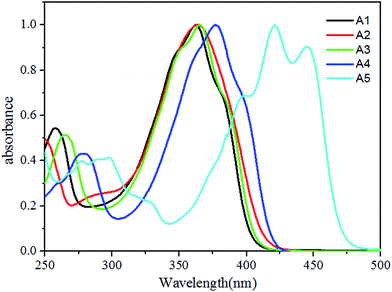 | ||
Fig. 2 Changes in absorption spectra of A1–A5 by alternating irradiation with UV-vis in EtOH/H2O (v/v = 4![[thin space (1/6-em)]](https://www.rsc.org/images/entities/char_2009.gif) : :![[thin space (1/6-em)]](https://www.rsc.org/images/entities/char_2009.gif) 1, 1.0 × 10−5 M) at room temperature. 1, 1.0 × 10−5 M) at room temperature. | ||
The ability of chemosensor A4 to form complex with metal ions was also studied using UV-vis spectroscopy (Fig. 3). The addition of Hg2+ to A4 caused a 28 nm red-shifted (from 377 to 405 nm), which changed the color from grey to yellow (Fig. 1). This phenomenon is similar to the addition of Hg2+ to chemosensors A1, A2, A3 and A5, respectively (Fig. S16–S19, in the ESI†). Hg2+ ion binding with chemosensors A1–A5 caused identical red-shifts and color changes. Hg2+ ion can induce deprotonation of active NH groups, especially those conjugated to aromatic or carbonyl groups. Such deprotonation process caused by complexation can be used for metal ions recognition and sensing.28 For the chemosensors based on ICT, the deprotonation of those coordinated atoms in electron-donating groups can greatly enhance their electron-donating ability and result in a red-shifted in absorption spectra. These results indicate the occurrence of coordination between the five chemosensors and Hg2+.
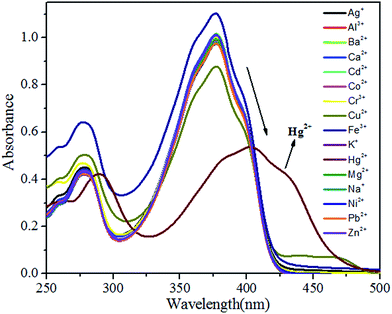 | ||
Fig. 3 Absorption changes of A4 in EtOH/H2O (v/v = 4![[thin space (1/6-em)]](https://www.rsc.org/images/entities/char_2009.gif) : :![[thin space (1/6-em)]](https://www.rsc.org/images/entities/char_2009.gif) 1, 1.0 × 10−5 M) upon addition of 1 equiv. of different nitrate salts (1.0 × 10−5 M). 1, 1.0 × 10−5 M) upon addition of 1 equiv. of different nitrate salts (1.0 × 10−5 M). | ||
To study the influence of other metal ions (Ag+, Al3+, Ba2+, Ca2+, Cd2+, Co2+, Cr3+, Cu2+, Fe3+, K+, Mg2+, Na+, Ni2+, Pb2+ and Zn2+) on Hg2+ the binding of with A1–A5, competitive absorption spectroscopic were experiments performed with Hg2+ (1.0 × 10−5 M) in the presence of other metal ions (5.0 × 10−5 M). Take A4 for example (Fig. 4), bars represent for the absorbance at the biggest intensity band of chemosensers. Green bars represent the addition of 2 equivalent of metal ions (Ag+, Al3+, Ba2+, Ca2+, Cd2+, Co2+, Cr3+, Cu2+, Fe3+, K+, Mg2+, Na+, Ni2+, Pb2+, Zn2+ and blank, respectively) to the chemosensor solution. Red bars represent the subsequent addition of 1 equivalent of Hg2+ to the solution in the presence of competitive cations. Absorption changes caused by the mixture of Hg2+ with other metal ions were similar to that of Hg2+ alone. These facts confirmed that the selectivity of A1–A5 for Hg2+ ion detection is higher than other metal ions.
Detection limits and association constants
In order to prove the selectivity of A1–A5 towards Hg2+, the detection limits29 were calculated as shown in Table 1. Assuming a 2![[thin space (1/6-em)]](https://www.rsc.org/images/entities/char_2009.gif) :
:![[thin space (1/6-em)]](https://www.rsc.org/images/entities/char_2009.gif) 1 molar ratio forms the ligand/Hg2+ complex, the association constant (K) was calculated on the basis of the titration curves of A1–A5 with Hg2+. To further confirm the superior selectivities of A1–A5 towards Hg2+, the pH effects of their responses are evaluated as explained below.
1 molar ratio forms the ligand/Hg2+ complex, the association constant (K) was calculated on the basis of the titration curves of A1–A5 with Hg2+. To further confirm the superior selectivities of A1–A5 towards Hg2+, the pH effects of their responses are evaluated as explained below.
| K | Detection limit | |
|---|---|---|
| A1 | 6.88 × 102 | 2.40 × 10−6 |
| A2 | 4.89 × 102 | 3.13 × 10−6 |
| A3 | 3.11 × 103 | 2.74 × 10−6 |
| A4 | 3.62 × 103 | 1.93 × 10−6 |
| A5 | 2.12 × 103 | 3.13 × 10−6 |
Stoichiometries and affinity constants of chemosensors with Hg2+
To explore the quantitative interrelation and the interaction mode of chemosensors with Hg2+ ion, the coordination reaction of A4 with Hg2+ ion was monitored by UV-vis spectroscopic titration (Fig. 5). After the addition of Hg2+ ion (0.5 equimolar per drop), the peak of A4 at 279 nm showed significant red-shifted (about 9 nm) to the peak of B4 at 288 nm. The peak at 377 nm was found to become weaker and red-shifted with increasing amounts of Hg2+ ion. A new band centered at 382 nm started to develop with a distinct isosbestic point at 405 nm, indicating strong interactions between A4 and the Hg2+. No difference was observed in the absorption spectra once the 2![[thin space (1/6-em)]](https://www.rsc.org/images/entities/char_2009.gif) :
:![[thin space (1/6-em)]](https://www.rsc.org/images/entities/char_2009.gif) 1 molar ratio of A4/Hg2+ was reached, which clearly indicated the formation of [Hg(A4)2]n.
1 molar ratio of A4/Hg2+ was reached, which clearly indicated the formation of [Hg(A4)2]n.
In order to further ensure the binding sites of A1–A5, take A4 for example, the stoichiometries of A4 + Hg2+ were calculated through Job's plots as shown in Fig. 6 the stoichiometries of A4 + Hg2+ was established by Job's plots between the mole fraction (XM) and maximum absorption intensities at 430 nm, respectively. Upon the addition of 0–30 μM of Hg2+ (with an equal span of 3 μM), the absorption maxima of A4 were quenched rapidly up to 10 μM, afterwards they were found to be restored again. Therefore, the Job's plots intensities displayed a absorption maxima at a molar fraction of ca. 0.66 (A4 + Hg2+), as shown in Fig. 6, representing their 2![[thin space (1/6-em)]](https://www.rsc.org/images/entities/char_2009.gif) :
:![[thin space (1/6-em)]](https://www.rsc.org/images/entities/char_2009.gif) 1 stoichiometric complexation.30
1 stoichiometric complexation.30
Benesi–Hildebrand (B–H) method is a widely used approach in physical chemistry for the determination of equilibrium constant K and stoichiometry of non-bonding interactions. This approach could generate stoichiometric conclusions for bonding interaction, such as charge-transfer complexes and host–guest molecular complexation.
| nL + M → MLn |
According to Benesi–Hildebrand equation.
Taking logarithm on both side of equation
Based on the 2![[thin space (1/6-em)]](https://www.rsc.org/images/entities/char_2009.gif) :
:![[thin space (1/6-em)]](https://www.rsc.org/images/entities/char_2009.gif) 1 stoichiometry and the Job's plot, the stability constant of the complex between A1 and Hg2+ was estimated to be 6.88 × 102 by plotting lg[(Al − A0)/(A − A0)] against lg{1/[Hg2+]}, all the experiment-based stability constants are calculated listed in Table 1. From Table 1, A3 has the biggest stability constant of the five chemosensors, meaning A3 has the greatest potential application as Hg2+ chemosensor. Due to its wide absorbance peak and poor red-shift ability, A5 does not perform as well as the other four ligands (Fig. 7).
1 stoichiometry and the Job's plot, the stability constant of the complex between A1 and Hg2+ was estimated to be 6.88 × 102 by plotting lg[(Al − A0)/(A − A0)] against lg{1/[Hg2+]}, all the experiment-based stability constants are calculated listed in Table 1. From Table 1, A3 has the biggest stability constant of the five chemosensors, meaning A3 has the greatest potential application as Hg2+ chemosensor. Due to its wide absorbance peak and poor red-shift ability, A5 does not perform as well as the other four ligands (Fig. 7).
pH effects
To demonstrate the Hg2+-induced deprotonation of the imine group in A1–A5, pH titration experiments were carried out. First, the influence of pH on chemosensor A4 was studied using UV-vis spectroscopy. Over a pH range of 5–10, the visible absorption band centered at 405 nm stays unchanged. A decrease in pH from 5 to 1 engendered a shift in the maximum absorption wavelength, which was due to protonation of the imine group.16 The effect of pH on Hg2+ binding to A4 was further studied by monitoring A4–Hg2+ complex at a wavelength of 405 nm (Fig. 8). The absorbance suddenly increased at pH 5.0 and reached a maximum over a pH range of 5.0–10.0, indicating that the formation of A4–Hg2+ complex is a deprotonation process.31 When the pH value exceeded 10, the absorbance gradually decreased during to the dissociation of A4–Hg2+ complex, which resulted in lower absorbance at 405 nm. The absorbance was almost negligible at pH values less than 3 clearly that evidently the A4–Hg2+ complex do not exist over this pH range.32 Because the five chemosensors were modified by different electron functional aromatic moieties, their abilities of protonation and deprotonation were different. Therefore, the five chemosensors' detection ranges of pH values were different.Single crystal diffraction study
Single crystals of A4 were obtained by diffusion of EtOH to dichloromethane solution of A4. Single-crystal X-ray diffraction study reveals that A4 crystallized in the monoclinic crystal system with P21/c space group. The crystallographic details are provided in Table 2. A large planar can be seen between benzene and aminomalonitrile, which are quite conjugated as shown in Fig. 9a. The C–C and C–N bonds distances are in the range of 1.370(20)–1.458(19) and 1.285(18)–1.392(18) Å, respectively. There exists weak non-classical C–H⋯O intramolecular hydrogen bonds involving methoxy groups with methenyl group (C⋯O = 2.804–3.464 Å) as well as N–H⋯N intramolecular interaction between the amino and imino group (N⋯N = 2.791 Å), which play a vital role in the consolidation of the A4 molecule. Via N–H⋯N intermolecular interactions between the amino and neighboring cyano groups (N⋯N = 3.020–3.088 Å, N–H⋯N = 137–169°) as well as the nonclassical C–H⋯O hydrogen bonds interaction between benzene rings and neighboring methoxy groups (C⋯O = 3.393 Å, C–H⋯O = 151°), the A4 molecules are interlinked into a two-dimensional supramolecular network (Fig. 9c).| Identification code | A4 | B4 |
|---|---|---|
| a R1 = ∑||Fo| − |Fc||/∑|Fo|.b wR2 = [∑w(Fo2 − Fc2)2/∑w(Fo2)2]1/2. | ||
| Empirical formula | C14H14N4O3 | C28H24HgN8O6 |
| Mr/g mol−1 | 286.29 | 769.14 |
| T/K | 110(2) | 153(2) |
| Crystal system | Monoclinic | Monoclinic |
| Space group | P21/c | C2/c |
| a/Å | 14.022(4) | 17.206(6) |
| b/Å | 7.417(2) | 13.808(3) |
| c/Å | 13.758(4) | 13.936(4) |
| α/° | 90.00 | 90.00 |
| β/° | 90.41(3) | 122.01(3) |
| γ/° | 90.00 | 90.00 |
| V/Å−3 | 1430.77(7) | 2807.35(14) |
| Z | 4 | 4 |
| ρc/g cm−3 | 1.329 | 1.820 |
| μ/mm−1 | 0.097 | 5.541 |
| Reflections collected | 5133 | 16![[thin space (1/6-em)]](https://www.rsc.org/images/entities/char_2009.gif) 304 304 |
| Unique reflections | 2810 | 2757 |
| Rint | 0.021 | 0.038 |
| R1a (I > 2σ(I)) | 0.036 | 0.018 |
| wR2b (all data) | 0.099 | 0.042 |
 | ||
| Fig. 9 (a) Molecular structure of A4. (b) Coordination structure of complex B4. H atoms omitted for clarity. (c) Perspective views of hydrogen-bonding interactions in A4. | ||
It also reveals that complex B4 crystallized in the monoclinic crystal system with C2/c space group. The asymmetric unit contains one half of the formula unit and consists of one crystallographically unique Hg atom and one A4 (Fig. 9b). Hg atom lies in a special position (SOF = 0.5), being four-coordinated by two amino and two imino nitrogen atoms from two different A4 (Hg–N = 2.034(2)–2.647(2) Å). The two A4 molecules have a dihedral angle ca. 19.69° (based on the benzene rings), being located at the same side of Hg atom. There exists weak non-classical C–H⋯O intramolecular hydrogen bonds between methoxy groups (C⋯O = 2.826–3.168 Å), which play a significant role in the construction of the mononuclear Hg unit. Via C–H⋯N intermolecular interactions between the methoxy groups and neighboring cyano groups (C⋯N = 3.106–3.457 Å, N–H⋯N = 102–149°), the B4 molecules are interlinked into a two-dimensional supramolecular network (Fig. 10).
Theoretical calculation study
In order to further understand the behavior of A4 with the Hg2+, DFT calculations have been carried out. As Hg2+ is known for its four-coordination complex, the input structures were designed in the same way to have bidentate coordination with DMN. The structural optimization was done using the Gaussian 09W package adopting the B3LYP method with SDD as the basic set. TD-DFT calculations investigate the change of the absorption spectra upon addition of Hg2+. Electron density of both HOMO and LUMO of A4 and B4 lies on the electron-withdrawing part. From the energy level diagram (Fig. 12), it can be seen that addition of the metal ions leads to the stabilization of the HOMO and LUMO of these chemosenors. Both HOMO and LUMO of the B4 and A4 were shown in Fig. 11, which are mainly dominated by molecular orbitals from A4. The contribution from Hg2+ ion to all these orbitals is significant. The electron density of the HOMO is localized on the whole conjugate part of the molecular, whereas the LUMO distribute on the diaminomaleonitrile and the imine moiety. For complex B4, its HOMO is more strongly localized than that in A4, and the localization on the cyano group of the diaminomaleonitrile from Hg atom is disappeared. The LUMO of complex B4 is more located in the benzene ring and its localization on the cyano group of diaminomaleonitrile from Hg atom is also disappeared. Therefore, it can be concluded that the electronic π–π* transition in these complexes are localized on the 2-substituted diaminomaleonitrile ligands.The calculated HOMO–LUMO energy gaps (Eg) are summarized in Fig. 12. From the energy level diagram, complex B4 has a lower LUMO energy level of −4.59 eV, while ligand A4 has that of −2.50 eV. So it can be concluded that the coordination of Hg stabilized the LUMO of the complex. The HOMO energy levels of A4 and B4 are calculated to be −6.01 and −5.33 eV, respectively, showing that the HOMO energy level of A4 is a bit higher than that of B4. The calculated HOMO–LUMO energy gaps (Eg) obtained from DFT calculations were 3.51 and 0.74 eV for A4 and B4, respectively. The complex B4 has much smaller energy gap and longer wavelength of emission than that of A4. These data are consistent with the optical energy gaps as well as the band gap trend is in good agreement with the optical data.
Conclusion
In summary, five diaminomaleonitrile-based chemosensors were designed for naked-eye detection of Hg2+, which were investigated with much higher selectivity over other competitive metal ions. They displayed strong colorimetric responses with slight red-shift absorptions that were useful for easy detection of Hg2+ by naked eyes visualization. Adequate characterization and studies were carried out to confirm the chemosensors A1–A5 and their sensing behaviors toward Hg2+ ion. The binding mode study showed that the diaminomaleonitrile chemosensor formed a 2![[thin space (1/6-em)]](https://www.rsc.org/images/entities/char_2009.gif) :
:![[thin space (1/6-em)]](https://www.rsc.org/images/entities/char_2009.gif) 1 complex with Hg2+ where the imine group played a critical role in the selective binding of Hg2+ ion. Their recognition behavior can function well over a wide range of pH value, making them suitable for detection of Hg2+ ion in industrial and environmental fields.
1 complex with Hg2+ where the imine group played a critical role in the selective binding of Hg2+ ion. Their recognition behavior can function well over a wide range of pH value, making them suitable for detection of Hg2+ ion in industrial and environmental fields.
Acknowledgements
This work was supported by the National Natural Science Foundation of China (21172047 and 21372051), the Excellent Young Teacher Development Project of Universities in Guangdong Province (261532106) and the Guangzhou Science and Technology Program (201510010156).Notes and references
- P. B. Tchounwou, W. K. Ayensu, N. Ninashvili and D. Sutton, Environ. Toxicol., 2003, 18, 149–175 CrossRef CAS PubMed.
- T. W. Clarkson, L. Magos and G. J. Myers, N. Engl. J. Med., 2003, 349, 1731–1737 CrossRef PubMed.
- Q. Zhao, F. Y. Li and C. H. Huang, Chem. Soc. Rev., 2010, 39, 3007–3030 RSC.
- Y. M. Yang, Q. Zhao and W. Feng, Chem. Rev., 2013, 113, 192–270 CrossRef CAS PubMed.
- A. T. Wright and E. V. Anslyn, Chem. Soc. Rev., 2006, 35, 14–28 RSC.
- E. M. Nolan and S. J. Lippard, Chem. Rev., 2008, 108, 3443–3480 CrossRef CAS PubMed.
- B. H. Tong, Y. Zhang, Z. Han, D. Y. Chen and Q. F. Zhang, Inorg. Chem. Commun., 2013, 28, 31–36 CrossRef CAS.
- J. M. Lo, J. C. Yu, F. I. Hutchison and C. M. Wai, Anal. Chem., 1982, 54, 2536–2539 CrossRef CAS.
- H. N. Kim, W. X. Ren, J. S. Kim and J. Yoon, Chem. Soc. Rev., 2012, 41, 3210–3244 RSC.
- D. Sareen, P. Kaur and K. Singh, Coord. Chem. Rev., 2014, 265, 125–154 CrossRef CAS.
- M. E. Jun, B. Roy and K. H. Ahn, Chem. Commun., 2011, 47, 7583–7601 RSC.
- X. Chen, T. Pradhan, F. Wang, J. S. Kim and J. Yoon, Chem. Rev., 2012, 112, 1910–1956 CrossRef CAS PubMed.
- J. Jiang, W. Liu, J. Cheng, L. Yang, H. Jiang, D. Bai and W. Liu, Chem. Commun., 2012, 67, 8371–8378 RSC.
- J. Y. Park, B. G. In, L. N. Neupane and K. Lee, Analyst, 2015, 140, 744–749 RSC.
- Y. Yang, K. Yook and J. Tae, J. Am. Chem. Soc., 2005, 127, 16760–16761 CrossRef CAS PubMed.
- J. Park, B. In and K. H. Lee, RSC Adv., 2015, 5, 56356–56361 RSC.
- S. H. Kim and S. Matsumoto, Dyes Pigm., 2007, 72, 406–408 CrossRef CAS.
- T. A. Schwarze, H. Kelling, M. Muller, T. Trautmann, O. Klamroth, P. S. Baumann and H. J. Holdt, Chem.–Eur. J., 2012, 18, 10506–10510 CrossRef CAS PubMed.
- G. Consiglio, S. Failla, P. Finocchiaro, I. P. Oliveri, R. Purrello and S. D. Bella, Inorg. Chem., 2010, 49, 5134–5142 CrossRef CAS PubMed.
- V. Kumar, A. Kumar, U. Diwan, Shweta, Ramesh, S. K. Srivastava and K. K. Upadhyay, Sens. Actuators, B, 2015, 207, 650–657 CrossRef CAS.
- X. B. Sun, Y. Q. Liu, X. J. Xu, G. Yu, S. Y. Chen, W. F. Qiu, Y. Q. Ma, Z. H. Zhao and D. B. Zhu, Synth. Met., 2006, 156, 1174–1181 CrossRef CAS.
- L. Wang, P. Shen, Z. C. Cao, X. P. Liu, Y. S. Huang, C. Y. Liu, P. Chen, B. Zhao and S. T. Tan, J. Power Sources, 2014, 246, 831–839 CrossRef CAS.
- M. J. Maclachlan, M. K. Park and L. K. Thompson, Inorg. Chem., 1996, 35, 5492–5499 CrossRef CAS PubMed.
- S. Pagliari, R. Corradini, G. Galaverna and S. Sforza, et al., Chem.–Eur. J., 2004, 10, 2749–2758 CrossRef CAS PubMed.
- W. Li, Y. Zhang, X. Gan, M. Yang, B. Mie, M. Fang, Q. Zhang, J. Yu, J. Wu, Y. Tian and H. Zhou, Sens. Actuators, B, 2015, 206, 640–646 CrossRef CAS.
- J. Diego, M. M. Ramon, S. Felix and S. Juan, Tetrahedron Lett., 2004, 45, 1257–1259 CrossRef.
- D. Jiménez, R. Martínez-Máñez, F. Sancenón, J. V. Ros-Lis, J. Soto, Á. Benito and E. García-Breijo, Eur. J. Inorg. Chem., 2005, 2393–2403 CrossRef.
- H. P. Zhou, J. Q. Wang, Y. X. Chen, W. G. Xi, Z. Zheng, D. L. Xu, Y. L. Cao, G. Liu, W. J. Zhu, J. Y. Wu and Y. P. Tian, Dyes Pigm., 2013, 98, 1–10 CrossRef.
- J. Li, Y. Wu, F. Song, G. Wei, Y. Cheng and C. Zhu, J. Mater. Chem., 2012, 22, 478–482 RSC.
- M. Shellaiah, Y. H. Wu, A. Singh, M. V. Raju and H. C. Lin, J. Mater. Chem. A, 2013, 1, 1310–1318 Search PubMed.
- Q. Li, M. Peng, N. Li, J. Qin and Z. Li, Sens. Actuators, B, 2012, 173, 580–584 CrossRef.
- S. P. Wu, K. J. Du and Y. M. Sung, Dalton Trans., 2010, 39, 4363–4368 RSC.
Footnote |
| † Electronic supplementary information (ESI) available. CCDC 994864 and 994865. For ESI and crystallographic data in CIF or other electronic format see DOI: 10.1039/c5ra21474b |
| This journal is © The Royal Society of Chemistry 2016 |

